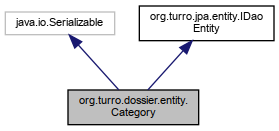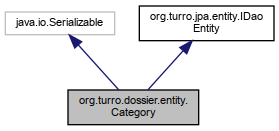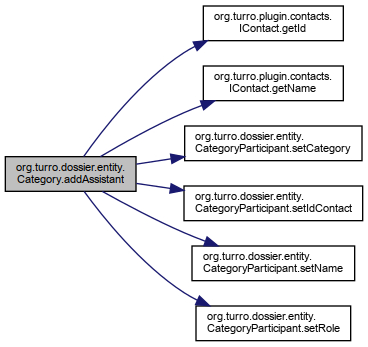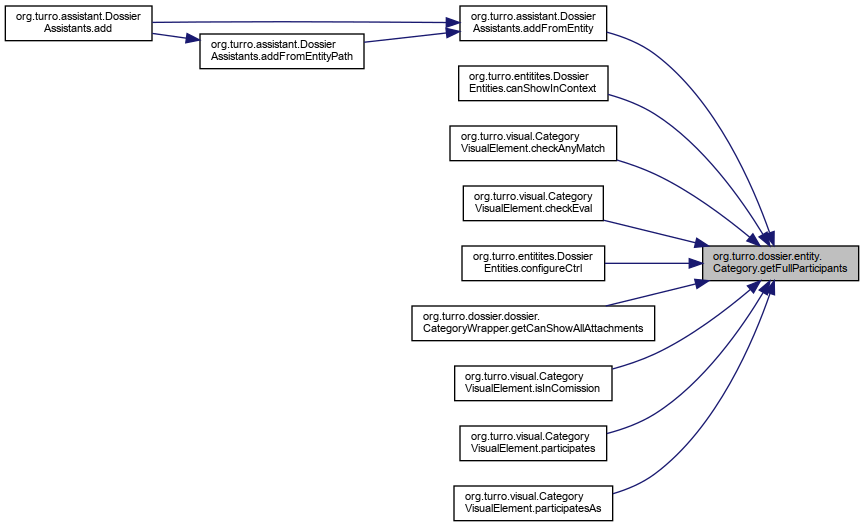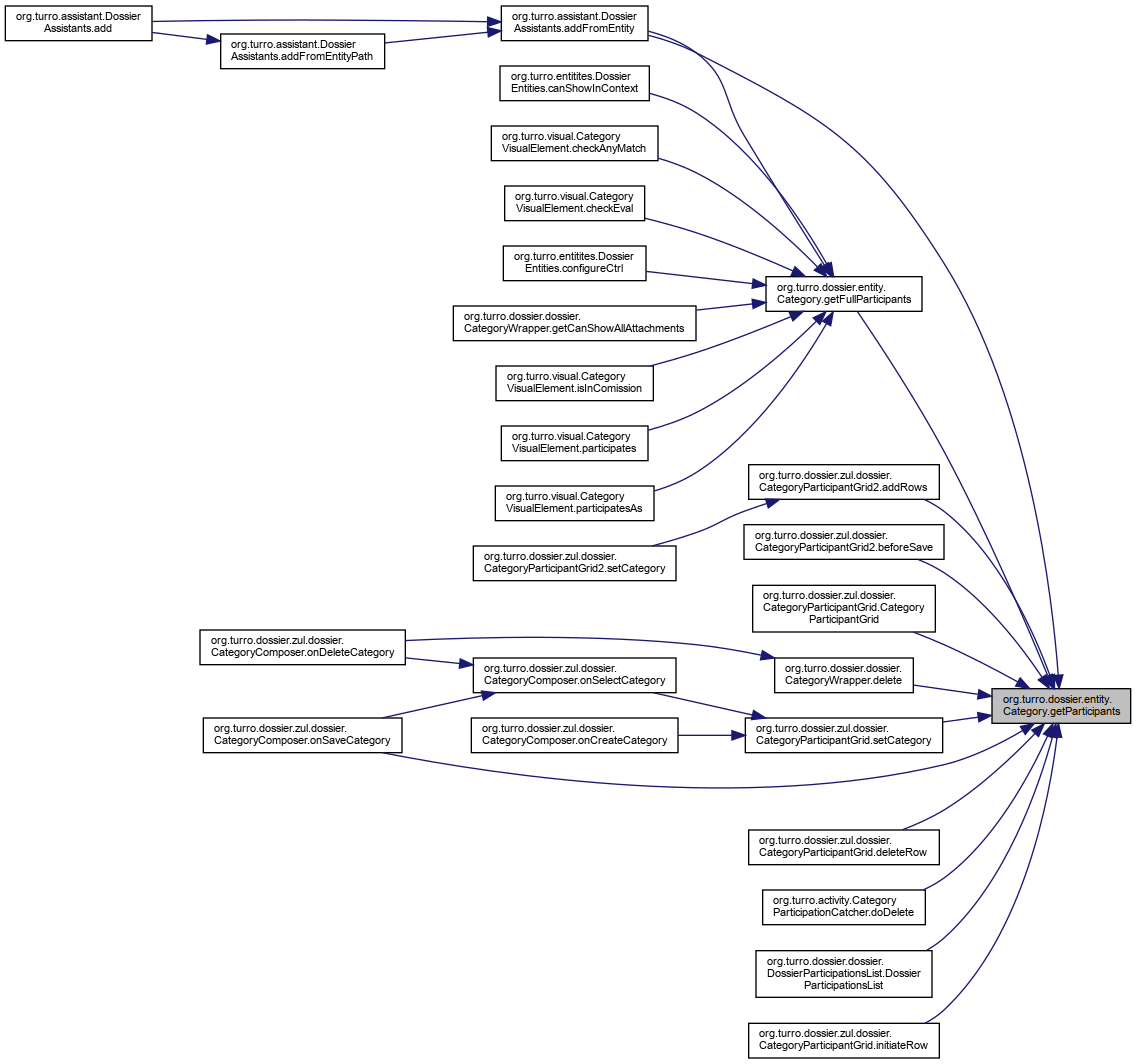- Author
- Lluis Turró Cutiller lluis.nosp@m.@tur.nosp@m.ro.or.nosp@m.g
Definition at line 54 of file Category.java.
◆ addAssistant()
Definition at line 213 of file Category.java.
214 if(contact ==
null)
return null;
215 CategoryParticipant p =
new CategoryParticipant();
217 p.setIdContact(contact.getId());
218 p.setName(contact.getName());
219 p.setRole(ParticipantRole.PARTICIPANT_ASSISTANT);
Set< CategoryParticipant > getParticipants()
◆ addOwner()
Definition at line 202 of file Category.java.
203 if(contact ==
null)
return null;
204 CategoryParticipant p =
new CategoryParticipant();
206 p.setIdContact(contact.getId());
207 p.setName(contact.getName());
208 p.setRole(ParticipantRole.PARTICIPANT_OWNER);
◆ entityId()
| Object org.turro.dossier.entity.Category.entityId |
( |
| ) |
|
◆ getChildren()
| Set<Category> org.turro.dossier.entity.Category.getChildren |
( |
| ) |
|
◆ getDefaultResponsible()
Definition at line 280 of file Category.java.
282 if(p.getRole().equals(role)) {
283 return Contacts.getContactById(p.getIdContact());
IContact getDefaultResponsible(ParticipantRole role)
◆ getDescription()
| String org.turro.dossier.entity.Category.getDescription |
( |
| ) |
|
◆ getDescriptors()
◆ getDirectOwners()
Definition at line 246 of file Category.java.
247 List<IDossierParticipant> list =
new ArrayList<>();
249 if(p.getRole().equals(ParticipantRole.PARTICIPANT_OWNER)) {
◆ getDossiers()
| List<Dossier> org.turro.dossier.entity.Category.getDossiers |
( |
| ) |
|
Definition at line 292 of file Category.java.
293 WhereClause wc =
new WhereClause();
294 wc.addClause(
"select d from Dossier d");
295 wc.addClause(
"where d.category = :category");
296 wc.addNamedValue(
"category",
this);
297 Dao dao =
new DossierPU();
298 return dao.getResultList(Dossier.class, wc);
◆ getFullDescription()
| String org.turro.dossier.entity.Category.getFullDescription |
( |
| ) |
|
◆ getFullParticipants()
Definition at line 270 of file Category.java.
271 ParticipantSet<IDossierParticipant>
set =
new ParticipantSet<>(
getParticipants());
274 set.addAll(c.getParticipants());
◆ getId()
| Long org.turro.dossier.entity.Category.getId |
( |
| ) |
|
◆ getParent()
| Category org.turro.dossier.entity.Category.getParent |
( |
| ) |
|
◆ getParticipants()
Definition at line 116 of file Category.java.
117 Dao dao =
new DossierPU();
118 if(
id !=
null &&
id > 0 && dao.isNotLoaded(participants)) {
119 participants = dao.lazyLoader(Category.class,
this,
"participants").participants;
◆ getPath()
| String org.turro.dossier.entity.Category.getPath |
( |
| ) |
|
Definition at line 256 of file Category.java.
257 if(!Strings.isBlank(fullDescription)) {
258 return "/" + fullDescription.replaceAll(
"\\s*\\" + Chars.backward() +
"\\s*",
"\\/");
◆ getPathToFullDescription()
| static String org.turro.dossier.entity.Category.getPathToFullDescription |
( |
String |
path | ) |
|
|
static |
Definition at line 263 of file Category.java.
264 if(!Strings.isBlank(path)) {
265 return path.substring(1).replaceAll(
"\\/",
" \\" + Chars.backward() +
" ");
◆ getUniquePath()
| String org.turro.dossier.entity.Category.getUniquePath |
( |
| ) |
|
◆ getWorths()
◆ isBranchAdmin()
| boolean org.turro.dossier.entity.Category.isBranchAdmin |
( |
IContact |
contact | ) |
|
Definition at line 235 of file Category.java.
237 if(p.getRole().equals(ParticipantRole.PARTICIPANT_OWNER) &&
238 contact.getId().equals(p.getIdContact()) &&
◆ isDirectOwner()
| boolean org.turro.dossier.entity.Category.isDirectOwner |
( |
IContact |
contact | ) |
|
Definition at line 224 of file Category.java.
226 if(p.getRole().equals(ParticipantRole.PARTICIPANT_OWNER)) {
227 if(contact.getId().equals(p.getIdContact())) {
◆ isEmpty()
| boolean org.turro.dossier.entity.Category.isEmpty |
( |
| ) |
|
◆ isKnowledgeBase()
| boolean org.turro.dossier.entity.Category.isKnowledgeBase |
( |
| ) |
|
◆ isOwnsProjects()
| boolean org.turro.dossier.entity.Category.isOwnsProjects |
( |
| ) |
|
◆ prepareSave()
| void org.turro.dossier.entity.Category.prepareSave |
( |
| ) |
|
Implements org.turro.jpa.entity.IDaoEntity.
Definition at line 189 of file Category.java.
190 IDaoEntity.super.prepareSave();
191 if(
id ==
null ||
id == 0) {
192 id = IdUtils.getNewLongIdFromLong(
new DossierPU(),
"Category",
"id");
194 if(Hierarchy.checkLoop(
this, (c) -> c.id, (c) -> c.parent)) {
◆ setChildren()
| void org.turro.dossier.entity.Category.setChildren |
( |
Set< Category > |
children | ) |
|
◆ setDescription()
| void org.turro.dossier.entity.Category.setDescription |
( |
String |
description | ) |
|
Definition at line 96 of file Category.java.
97 this.description = description;
◆ setDescriptors()
Definition at line 164 of file Category.java.
165 this.descriptors = descriptors;
◆ setFullDescription()
| void org.turro.dossier.entity.Category.setFullDescription |
( |
String |
fullDescription | ) |
|
Definition at line 132 of file Category.java.
133 this.fullDescription = fullDescription;
◆ setId()
| void org.turro.dossier.entity.Category.setId |
( |
Long |
id | ) |
|
◆ setKnowledgeBase()
| void org.turro.dossier.entity.Category.setKnowledgeBase |
( |
boolean |
knowledgeBase | ) |
|
Definition at line 148 of file Category.java.
149 this.knowledgeBase = knowledgeBase;
◆ setOwnsProjects()
| void org.turro.dossier.entity.Category.setOwnsProjects |
( |
boolean |
ownsProjects | ) |
|
Definition at line 156 of file Category.java.
157 this.ownsProjects = ownsProjects;
◆ setParent()
| void org.turro.dossier.entity.Category.setParent |
( |
Category |
parent | ) |
|
◆ setParticipants()
| void org.turro.dossier.entity.Category.setParticipants |
( |
Set< CategoryParticipant > |
participants | ) |
|
Definition at line 124 of file Category.java.
125 this.participants = participants;
◆ setUniquePath()
| void org.turro.dossier.entity.Category.setUniquePath |
( |
String |
uniquePath | ) |
|
◆ setWorths()
| void org.turro.dossier.entity.Category.setWorths |
( |
Set< WorthDefinition > |
worths | ) |
|
The documentation for this class was generated from the following file:
